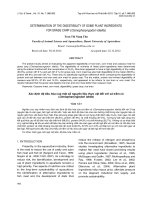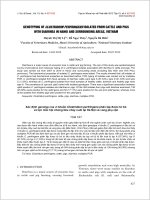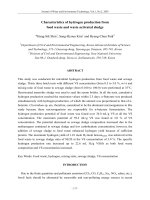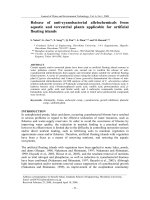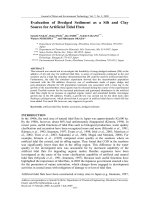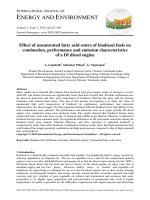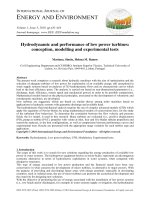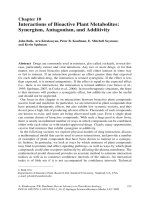Interactions of Bioactive Plant Metabolites - Synergism, Antagonism, and Additivity
Bạn đang xem bản rút gọn của tài liệu. Xem và tải ngay bản đầy đủ của tài liệu tại đây (503.79 KB, 18 trang )
Chapter 10
Interactions of Bioactive Plant Metabolites:
Synergism, Antagonism, and Additivity
John Boik, Ara Kirakosyan, Peter B. Kaufman, E. Mitchell Seymour,
and Kevin Spelman
Abstract Drugs are commonly used in mixtures, also called cocktails, to treat dis-
ease, particularly cancer and viral infections. Any two or more drugs, or for that
matter, two or more bioactive plant compounds, will either interact in some way
or fail to interact. If an interaction produces an effect greater than that expected
for each individual drug, the interaction is termed synergistic. If the effect is less
than expected, it is termed antagonistic. If the effect is equal to the expected effect
(i.e., there is no interaction), the interaction is termed additive (see Greco et al.,
1995; Spelman, 2007, in Cseke et al., 2006). In most therapeutic situations, the hope
is that mixtures will produce a synergistic effect, but additivity can also be useful
and should not be neglected.
Our focus in this chapter is on interactions between bioactive plant compounds
used in food and medicine. In particular, we are interested in plant compounds that
have potential therapeutic effects, but also exhibit low systemic toxicity, and thus
do not pose a high risk of producing adverse effects. Thousands of such compounds
are known to exist, and more are being discovered each year. Even a single plant
can contain dozens of bioactive compounds. With such a large pool to draw from,
there is nearly an unlimited number of ways in which compounds can be combined,
either with each other or with market-approved drugs. Clearly many opportunities
exist to find mixtures that exhibit synergism or additivity.
In the following sections we explore physical models of drug interaction, discuss
a mathematical model that can be used to assess interactions, and provide a number
of examples of plant compounds that have been shown to interact in a synergis-
tic fashion. In particular, we look at ways by which mixtures of plant compounds
may bind to proteins and affect signaling pathways, as well as ways by which plant
compounds could alter receptors indirectly by affecting the plasma membrane. The
mathematical model discussed provides an accurate method to estimate interaction
indices as well as to construct confidence intervals of the indices. An interaction
index is of little use if it is not accompanied by confidence intervals. Technical
J. Boik (
B
)
Department of Statistics Clark, Room S.264, Stanford University, Stanford, CA, USA
e-mail:
213
A. Kirakosyan, P.B. Kaufman, Recent Advances in Plant Biotechnology,
DOI 10.1007/978-1-4419-0194-1_10,
C
Springer Science+Business Media, LLC 2009
214 J. Boik et al.
aspects of the model are presented in order to provide a full description, but publi-
cally available software for the model can be used without a complete understanding
of the mathematics involved.
10.1 Introduction
We start this chapter by noting that most drugs approved for the market were not
developed with synergism in mind. The conventional regulatory process requires
that the safety and efficacy of a drug be based on the merits of the drug used alone. It
is only after market approval that assessment of synergistic interactions with other
approved drugs begins in earnest. The current guiding philosophy in drug devel-
opment is one of targeted therapy, whereby a single drug is designed to affect a
single protein target. This target could be a cell surface receptor or an intracellular
protein. The goal is to develop drugs that bind with high affinity to a target, but
have little affinity for off-target proteins. In this way, some adverse effects can be
avoided.
When developing bioactive plant compounds as drug mixtures, nutraceuticals, or
medicinal foods, an alternative philosophy is needed. The development process for
a mixture of plant bioactive compounds must necessarily be different from that for a
single-target drug. At least four primary differences between the two types of prod-
ucts stand out. First, rather than a single active constituent, there could be several or
even many dozens of active constituents in a plant extract. Indeed, a given meal rich
in plant compounds could contain hundreds of bioactive compounds, albeit in small
doses. Second, within the class of (reasonably) nontoxic plant compounds that are
the focus of this chapter, the binding affinity for known drug targets is often modest
to low. Rather than using a low dose of a single high-affinity compound, the opti-
mal clinical effect for many of these plant compounds might be seen when either a
relatively high dose of a single compound is administered or, as preferred, modest
doses of numerous compounds are given in a complex mixture that takes advantage
of additive and synergistic effects. Third, many plant compounds are promiscuous,
in that they bind with multiple targets, which may exist in different signaling path-
ways within the cell (Frantz, 2005; Aggarwal and Harikumar, 2009). Fourth, many
bioactive plant compounds, such as flavonoids and curcuminoids, are not soluble in
water, are metabolized to less-active conjugates or other products after oral adminis-
tration, or in some other way exhibit nonideal absorption, distribution, metabolism,
or excretion (ADME) characteristics. The fact that many bioactive plant compounds
bind with relatively low or modest affinity to known targets, bind with multiple tar-
gets, and/or exhibit poor pharmacokinetics rules them out as useful drugs according
to the conventional mode of thinking.
However, this does not mean that bioactive plant compounds do not and could
not play a highly useful role in health and medicine. Indeed, in spite of the fact that
most do not resemble a “silver bullet” drug, it is likely that such compounds are
responsible for much of the disease-prevention effects seen in human populations
that consume a diet rich in plant compounds (Liu, 2003). To understand how their
10 Interactions of Bioactive Plant Metabolites 215
beneficial properties can best be exploited, we must redefine, or at least expand, our
definition of a model drug.
Within the class of nontoxic bioactive plant compounds, the characteristics that
appear to limit their use in medicine also provide us with opportunities. The fact
that a plant extract or mixture of extracts may have a large number of bioactive
constituents means that there are abundant opportunities for additivity and syner-
gism. It should be emphasized that although synergistic interactions tend to receive
the most research attention, additive interactions are more common, and in large
mixtures they may play an even more important role than synergism. For example,
in a cytotoxicity study on doxorubicin and nine natural compounds against human
lung cancer cells, Boik and Newman (2008) found that synergism in smaller mix-
tures could allow a tenfold reduction in the concentration of doxorubicin needed to
produce a given effect level. Importantly, larger mixtures that exhibited less syn-
ergism (and more additivity) allowed a similar degree of reduction in doxorubicin
concentrations. In the larger mixtures, each drug was used at a lower concentration.
Additivity and synergism arise in mixtures through their ability to affect multi-
ple targets. The importance of affecting multiple targets cannot be overemphasized
when dealing with complex diseases such as cancer, chronic inflammatory diseases,
chronic viral infection, and many others. In these diseases, numerous macro home-
ostatic systems may be affected, as well as numerous intracellular and intercellular
signaling pathways. A large number of proteins can be involved, and each may be
considered as a potential target. For complex diseases, acceptance is growing in the
pharmaceutical industry for the design of mixtures or drugs capable of affecting
multiple targets (Tortora et al., 2004; Roth et al., 2004; Frantz, 2005; Zimmermann
et al., 2007).
Taking common solid tumors as an example, multiple signaling pathways can
be critically under- or overregulated (Chandran et al., 2007; Chan et al., 2008). As
tumors progress, the genetic machinery of tumor cells tends to become increasingly
unstable. When this occurs, more proteins can become involved and the tumor pop-
ulation becomes better able to adapt to drug therapy, immune attack, or other obsta-
cles to growth. It would seem unlikely that any single drug, particularly a drug that
affects a single target, would have a lasting effect on such a flexible cell population.
If the drug does not kill 100% of cells, there is a reasonable chance that the surviv-
ing cells will reestablish a population resistant not only to the applied drug but also
to other drugs. This characteristic is termed multidrug resistance. Cells may become
resistant through gene amplification and overproduction of the target protein, pro-
duction of proteins that pump the drug out of the cell, underproduction of proteins
that allow the drug to enter the cell, improved repair of drug-induced DNA damage,
production of proteins that inactivate the drug, and/or production of proteins that
serve the same function as the target protein but that are not affected by the drug.
Literally, hundreds of proteins could be involved in the progression of cancer and
developed resistance to drugs.
While plants may offer a rich source of bioactive compounds for use in mixtures,
do these compounds need to bind to their targets with high affinity in order to be
effective? Csermely et al. (2005) have proposed that in some cases, partial inhibition
216 J. Boik et al.
of multiple signaling pathways may be more efficient than complete inhibition of a
single pathway (see also Ágoston et al., 2005). This suggests that compounds that
exhibit modest binding affinity could still be useful.
Could administration of multiple compounds lead to adverse effects? Of course,
adverse effects are possible with any pharmacologic therapy. Thus, mixtures will
need to be designed carefully. But the risk of adverse effects can be minimized
through the use of relatively nontoxic compounds. In addition, keeping doses as
low as possible can reduce risks. Because of additivity and synergism in a well-
designed mixture, relatively low doses of individual compounds may still be capable
of producing a desired effect without excessive risk of toxicity.
Pharmacokinetic issues are also important when considering the medical and
health effects of plant compounds. While many otherwise interesting compounds
exhibit poor ADME characteristics, a good number of these could still be useful.
For example, the vehicle used to deliver the compounds could be altered to improve
the pharmacokinetics. In some cases, enteric-coated tablets, emulsifiers, complex-
ing agents, or lipid-based formulations might be useful. In addition to manipula-
tions based on physical pharmacy, the act of using mixtures of compounds can
in some cases affect ADME characteristics. For example, the ability of grapefruit
juice to affect drug metabolism is now well established. This is discussed more in
Chapter 14 in relation to adverse drug interactions. But beneficial effects on ADME
characteristics are also possible. For example, hypericin, thought to be one of the
active constituents of Hypericum perforatum (St. John’s wort), is nearly insoluble
in water. Jürgenliemk and Nahrstedt (2003) showed that some phenolic constituents
typical for Hypericum extracts increased the concentration of hypericin in the water
phase by up to 400-fold. Butterweck et al. (2003) showed that the oral bioavailability
of hypericin was increased if administered with hyperoside, also found in Hyper-
icum extracts. In another example, Gawande et al. (2008) found that oral adminis-
tration of a black grape extract along with (–)-epigallocatechin gallate (EGCG), a
green tea component, increased the systemic availability of EGCG in humans.
We see then that interactions in a mixture may be due to pharmacodynamic or
pharmacokinetic events (Spinella, 2002). In the former, the effects are due to two
or more drugs acting on single or multiple regulatory proteins. Such interactions
are often directly related to the binding affinity or membrane-altering ability of the
drugs. In contrast, pharmacokinetic interactions are due to influences of a compound
on another’s ADME characteristics.
10.2 Physical Models of Drug Interaction – Protein Binding
and the Plasma Membrane
As discussed above, drugs in a mixture may interact by binding to target proteins.
For convenience, we use the term drug here and in the remaining portions of this
chapter to refer to both approved drugs and bioactive plant compounds. The binding
of a drug to a protein may affect the function of that protein through a number of
10 Interactions of Bioactive Plant Metabolites 217
mechanisms. For example, if the protein were an enzyme that binds substrate S, the
drug could bind near the active site of the enzyme, thereby sterically inhibiting the
binding of S. If the enzyme contains an allosteric binding site, distant from the active
site, the drug may bind to the allosteric site and thereby affect the conformation of
the active site and its ability to bind S. When multiple drugs affect a single protein,
the complexity of binding patterns and the mechanical alteration of protein function
will influence the type of interaction produced: additive, synergistic, or antagonistic.
If multiple proteins are involved, the complexity of the (signaling) network in which
the target proteins exist will also influence the type of interaction produced.
As a simple example, targets could be two intracellular enzymes serially con-
nected in a signaling pathway. In this case, inhibition of an enzyme by each drug
in a binary mixture might produce additive effects. In more complex cases, drugs
may affect multiple proteins in a signaling pathway that contains positive and/or
negative feedback loops or drugs may affect proteins that are involved in distinct
but connected signaling pathways. As the number of bound proteins and the com-
plexity of the signaling pathways increase, there are increasing opportunities for
antagonistic or synergistic interactions.
In addition to intracellular proteins, drugs may also bind to protein targets on the
plasma membrane. In particular, they may bind to transmembrane receptors embed-
ded in the lipid bilayer. Many signals that originate outside of the cell enter the cell
via cell surface receptors. Growth factors, such as epidermal growth factor (EGF),
are an example of an extracellular signal. Extracellular EGF binds to EGF receptors
(EGFR) on the plasma membrane, and the resulting signal is propagated into the
cell, eventually reaching the nucleus and causing proliferation.
Drugs can directly bind to receptor proteins on the plasma membrane, in some
cases stimulating signal transduction and in other cases inhibiting it. For exam-
ple, plant compounds that bind weakly with estrogenic receptors may physically
block the binding of more potent ligands, thereby producing an antiestrogenic effect.
Genistein, from soybean, is reported to act in part by this mechanism in some experi-
mental models (Kogiso et al., 2006). If multiple therapeutic compounds are used and
multiple receptor types are affected, downstream signaling pathways may interact
in additive, antagonistic, or synergistic ways.
The interaction of drugs can be influenced by the properties of the plasma mem-
brane that contains the receptors. Although the membrane has been described as a
system driven by thermodynamic equilibrium (Aon et al., 1996), it is more accu-
rately seen as an emergent structure consisting of highly asymmetrical structures
and undergoing dynamic transitions (Perillo, 2002). Typically, mammalian cellular
plasma membranes consist of about eight major classes of lipids (Simons and Vaz,
2004) and also include a variety of proteins embedded in the bilipid structure. The
plasma membrane serves a number of purposes, including protection, endocytosis,
signaling, and mechanical stability. It must be rigid enough to protect the cell and
offer stability, but at the same time, it must be dynamic and pliable enough to allow
cell deformation and promote adaptation to diverse environmental messages. Either
directly or indirectly, the characteristics of the lipid membrane affect nearly every
activity that occurs in a cell.
218 J. Boik et al.
One way that the membrane affects signaling is by supporting the dynamic cre-
ation and movement of lipid rafts (also known as membrane rafts), which are clus-
ters of proteins that horizontally “float” in the membrane. One report has identified
as many as 250 proteins that exist in lipid rafts (Patra, 2008). A good number of these
proteins, including ras (ras is a signal transduction protein that belongs to a large
superfamily of low-molecular-weight G proteins) and EGFR, are cell surface recep-
tors. Several authors have postulated or shown that receptors in a raft can cooperate
to affect each other’s conformation, thereby coordinating the overall response to a
ligand (Duke and Bray, 1999; Graham and Duke, 2005; Fuxe et al., 2008; Sourjik,
2004). For example, consider a receptor that switches probabilistically between two
conformations, active and inactive, and binding of a ligand stabilizes the active state.
Certain cellular responses, such as chemotaxis, in response to a chemoattractant, are
most useful if they are binary. For example, it might be beneficial if a cell moves
toward a weak stimulus with the same force that it moves toward a stronger stimu-
lus. This requires that as a group, the receptors act like an on/off switch.Onewayto
accomplish this is by allowing adjacent receptors in a raft to influence the confor-
mation, active or inactive, of one another. Above a critical but low ligand concentra-
tion, a small percentage of receptors are bound, but these cause unbound receptors
to switch to the active conformation. In a more complicated scenario, receptors may
simultaneously bind two ligands, and in this case, receptor–receptor interactions
may produce the equivalent of AND/OR logic gates. For example, if a cell senses
both poison and chemoattractant in the same location, it is beneficial if the cell does
not move toward the chemoattractant.
The switching characteristics mentioned above are dependent on receptor–
receptor interactions, which in turn are dependent upon the characteristics of lipid
rafts. The notion that membrane characteristics may influence the type of drug inter-
action (additive, antagonistic, or synergistic) begs the question of whether some
drugs may act directly on the plasma membrane itself, in addition to or in con-
trast to protein binding. Indeed, this seems to occur for a good number of drugs
and bioactive plant compounds. It is well known that hydrophobic drugs tend to
interact with biological membranes (Schreier et al., 2000). At high concentrations,
they can act like detergents and disrupt membranes, while at low concentrations,
they tend to stabilize membranes, such as protecting red blood cells from hemol-
ysis. Many bioactive plant products are also hydrophobic and can be expected to
interact with membranes. For example, some flavonoids have been shown to affect
lipid viscosity. In addition, flavonoids preferentially located in the hydrophobic por-
tion of the bilayer have been shown to initiate the formation of raft-like domains,
whereas those located in the polar interface region can fluidize membranes and have
a raft-breaking effect (Tarahovsky et al., 2008). In a study on human colon cancer
cells, the flavonoid quercetin was shown to induce the accumulation of cell death
receptors in lipid rafts and thereby facilitate apoptosis (programmed cell death) in
response to death-inducing signals (Psahoulia et al., 2007). Adachi et al. (2007)
reported that EGCG from green tea inhibited the binding of EGF to EGFR and the
subsequent activation of EGFR by altering membrane organization related to lipid
rafts. As a last example, omega-3 fatty acids (EPA, eicosapentaenoic acid, and DHA,
10 Interactions of Bioactive Plant Metabolites 219
docosahexaenoic acid) have been shown to inhibit the proliferation of human breast
cancer cells in vitro, in part by reducing EGFR levels in lipid rafts (Schley et al.,
2007).
In summary, the type of interaction produced by a drug mixture is influenced
by the complexity of protein binding patterns, the complexity of the network in
which the bound proteins interact, the degree of receptor–receptor interactions, and
the effects of drugs on the plasma membrane, particularly on the formation and
composition of lipid rafts. In the interest of brevity, other mechanisms by which a
drug can affect cellular function have not been discussed. For example, some drugs
can bind directly to DNA molecules. Many of these drugs, however, tend to exhibit
high systemic toxicity. Drugs can also affect cellular function by acting as pro- or
antioxidants.
10.3 Quantifying Synergism Using Nonlinear
Mixed-Effects Modeling
In the following discussion on mathematical models of drug interaction, we shift
to a more technical tone. In particular, the reader is given a complete mathematical
description of the MixLow method for assessing interaction indices developed by
Boik et al. (2008). An implementation of the MixLow method is currently available
in the R language (package mixlow) and can be downloaded from the CRAN web
site ( Although details of the model are presented here,
the R package can be used without a complete understanding of the mathematics
involved. For those readers who are not biostatisticians, the details given here should
provide a general insight into the many issues involved in estimating an interaction
index, and for those who do become users of the mixlow package or other software,
the details should provide useful reference material.
10.3.1 Background
Over the last few decades, several mathematical methods have been proposed to
assess synergism between drugs in a mixture.
1
All of these are based on some index
of additivity (or null interaction). There has been disagreement on a strict math-
ematical definition of additivity and reviews have been published discussing the
various proposals (Berenbaum, 1989; Greco et al., 1995; Merlin, 1994; Tallarida,
2001). Two indices that have gained widespread acceptance are those for Loewe
1
Where convenient and not confusing, the continuum of antagonism/additivity/synergism is
referred to as degrees of synergism.Thetermmethod is used to refer to the combination of a
model to estimate concentration–response curve parameters, an interaction index, and a procedure
to calculate confidence intervals. The term confidence interval is used to refer to the nominal 95%
confidence interval of the Loewe index or other interaction indices.
